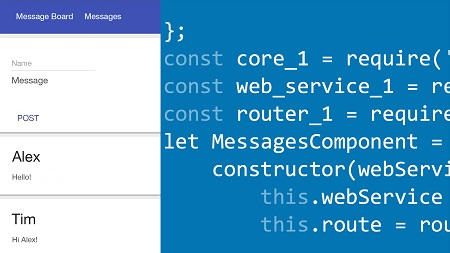
English | MP4 | AVC 1280×720 | AAC 48KHz 2ch | 3h 44m | 711 MB
Angular 2 and ASP.NET Core offer solid improvements over previous versions. In this course, discover how to work with these technologies to build a full-stack web application—which you can later use as a template for your own web app. Follow Alexander Zanfir as he explains how to create and configure your Angular 2 project, display data in Angular, and get data from ASP.NET Core. He also covers working with traditional template forms and reactive forms, creating different routes that you can navigate to, and using Entity Framework and token authentication for user registration, login, and simple authorization.
Topics include:
- Setting up the app infrastructure
- Creating and configuring the Angular 2 project
- Displaying data in Angular
- Refining the layout
- Creating the ASP.NET Core project
- Creating a controller with ASP.NET Core
- Creating a nav bar
- Registering users
- Authorizing resources
Table of Contents
1 Welcome
2 What you should know
3 Using the exercise files
4 Demo application overview
5 Architectural overview
6 Download and install ASP.NET Core
7 Create and configure the Angular 2 project
8 Create the component
9 Show data
10 Refine the layout
11 Create the ASP.NET Core project
12 Creating a service
13 Updating Angular to get data from our service
14 Saving our data to ASP.NET
15 Saving data to a list
16 Creating the component
17 Getting our input data
18 Communicating between multiple components with Output and ViewChild
19 Creating a data store in our service
20 Handling errors with try or catch
21 Create a nav bar
22 Navigate to a different view
23 Add a messages route
24 Pass a route parameter
25 Retrieve a route parameter
26 HTTP GET with Observable
27 Broadcast an event with subject
28 Use Observables and the async pipe
29 Create a register layout
30 Reactive forms with FormBuilder
31 Validate with reactive forms
32 Validate passwords with a custom validator
33 Validate emails with a custom validator
34 Create an Angular auth service
35 Create an ASP.NET register service
36 Persistency with Entity Framework
37 Save messages and users
38 Store a token with Angular
39 Implementing an authentication check
40 Log out
41 Create an Angular login component
42 Create the login services
43 Get user information
44 Add claims to our token
45 Send token with Angular HTTP requests
46 Auth middleware with AspNetCore.Authentication.JwtBearer
47 Access user through the Claim Subject
48 Edit user in Angular
49 Update user name when posting
50 Next steps
Resolve the captcha to access the links!